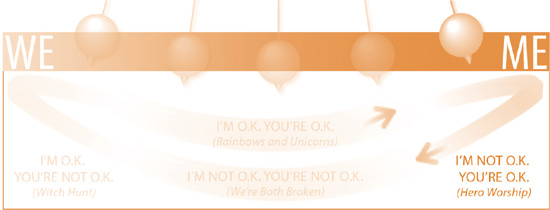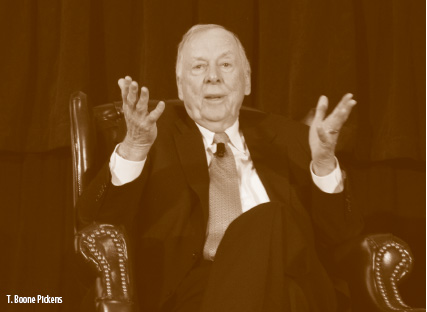

The second half of an Upswing of “Me” is when the new values adopted during the six-year transitionary window have so fully permeated our society that we become largely unaware of their influence. The happy, bouncy purity of “being true to yourself” has begun to degenerate into a contest over who is the most unique.
When we’re not being symbolic and cryptic in a “Me,” we’re singing sappy-happy songs and jingles about “apple trees and honey bees and snow-white turtledoves.” Do you remember Jonathan Livingston Seagull?
The following are the best-selling books of 1973 according to Publishers Weekly.
Figure 13.1 Best-selling books from an upswing into “ME.”
| BEST-SELLING BOOKS IN AN UPSWING OF “ME” (1973) | ME |
| 1. Jonathan Livingston Seagull, Richard Bach | |
| This is the parable of a seagull that breaks away from the flock and sets out to find himself. More than a million of us read it and said dreamily, “I see myself in that bird . . . He flies so high. . . all alone. . . and no one understands him. Yes, that bird is me. | |
| 2. Once Is Not Enough, Jacqueline Susann | |
| This is the story of a young woman’s drug use and sexual escapades. The book ends as she tries LSD and takes part in an orgy. She then wanders onto the beach, where she hallucinates that she sees her father and walks into the ocean after him, presumably drowning. | |
| 3. Breakfast of Champions, Kurt Vonnegut | |
| The story of “two lonesome, skinny, fairly old white men on a planet which was dying fast.” One of these men, Dwayne Hoover, is a normal-looking but deeply deranged Pontiac dealer and Burger Chef franchise owner who becomes obsessed with the writings of a science fiction author, Kilgore Trout, taking them for literal truth. Dwayne Hoover comes to believe that he, Dwayne Hoover, is the only individual in the universe with free will.1 | |
These are the international hit songs of 1973.
Figure 13.2 Popular music themes during a “ME” Zenith.
| POPULAR MUSIC THEMES: AN UPSWING OF “ME” REACHES ITS LIMITS I (1973) | ME |
| SYMBOLIC AND CRYPTIC AND SINGING SAPPY-HAPPY SONGS | |
1. “Angie,” The Rolling Stones |
MESSAGE |
| Angie, you’re beautiful, but ain’t it time we said good-bye? |
I loved you. I had you. Now I’m leaving you. |
2. “Tie a Yellow Ribbon Round the Ole Oak Tree,” Tony Orlando & Dawn |
|
| Now the whole damn bus is cheering And I can’t believe I see A hundred yellow ribbons ‘round the old oak tree. I’m comin’ home. |
I needed forgiveness and you gave it to me. Life is good! |
3. “Killing Me Softly with His Song,” Roberta Flack |
|
| He sang as if he knew me in all my dark despair and then he looked right through me as if I wasn’t there. |
I was in pain but a song made me feel better. |
4. “You’re So Vain,” Carly Simon |
|
| You’re so vain, I’ll bet you think this song is about you. Don’t you? Don’t you? Don’t you? |
Even though you’re successful, you’re still posing. |
ME |
What began as a beautiful dream of individuality and freedom of expression was devolving into plastic, hollow, phony posing. |
Carly Simon’s “You’re So Vain” reminds me of a comment one of our board members made to a classroom full of business owners assembled at Wizard Academy on July 1, 2007. Dr. Richard D. Grant, a renowned psychologist and a teacher of consumer behavior in the MBA program at the University of Texas, said,
ME The great problem in the United States is not repression or neurosis, which it was in Europe when Freud wrote about everything. No, the great problem here is not repression—it’s narcissism and addiction. Those are our great problems in the United States because Tommy Jefferson set us up. “Life, Liberty, and the . . . Pursuit of Happiness!” If you pursue happiness directly, it evades you. But you feel entitled to it . . . It’s wonderful, but it has a dark side. And the dark side is addiction. Addiction. We have done a dance with addiction in this country from the very beginning.
Freud wrote about repression during the Upswing of a “We.” His core belief was, “If it feels good, do it.” Freud believed self-denial to be the root of virtually every psychological problem. Freud was a champion of “Me.”
| 5. “The Ballroom Blitz,” The Sweet | MESSAGE |
| And the man in the back said ‘Everyone attack,’ And it turned into a ballroom blitz. |
It’s fun when things get crazy and out of control. |
| 6. “Crocodile Rock,” Elton John | |
| Well, Crocodile Rocking is something shocking when your feet just can’t keep still. I never knew me a better time and I guess I never will.” | I remember the innocence and simplicity of yesterday. |
In 1978, a decade since 1968, the final year of our six-year transitionary window, we were only five years out from the Zenith of “Me.”
During this time rock and roll took a lesson from Las Vegas and leapt into over-the-top showmanship. Put a cowboy, a policeman, a construction worker, an Indian chief, a biker and a G.I. on stage in full costume and what have you got? The Village People:
ME |
It’s fun to stay at the Y-M-C-A! |
Watching the Village People was as if society had said, “Now that we’ve discovered the spectacle of circuses, let’s see how far we can push it.”
Do you remember the studded, black leather outfits and grease-paint makeup of the rock band KISS? Groups like these soared during the second half of the Upswing of “Me,” as our hunger for individuality entered the realm of costumes.
Yes, things were getting out of hand.
Today we look back on bands like KISS and the Village People and realize how silly they were. But that wasn’t our feeling at the time. Looking proudly at us from the posters on our walls, these bands said, “These aren’t costumes—we’re just expressing the real person that each of us is inside. Each member of this band is unique and special and different. And don’t you wish you were me?”
Strangely, KISS and the Village People weren’t the Zenith of the “Me”; they were merely two of the strange bands leading up to it.
1983: Zenith of “Me”
When we finally get to the Zenith of “Me,” we find there’s nothing there. Individuality has degenerated into a costume party. Men no longer walk on the beach; they just move forward by striking a series of poses. The once-heartfelt music of singer-songwriters has devolved into big hair, disco, and glam rock. In business, “branding campaigns” are when advertisers wear costumes to the Media Masquerade Ball. Marketers are paid to make promises that businesses have no intention of keeping.
Figure 13.3 Moving into a Zenith of “ME.”

Literature in a “Me” thrives on fantasy, terror, and heroes. Take a look at the best-selling books for 1983 according to Publishers Weekly.
Figure 13.4 Popular Literature in the Zenith of a “ME” cycle.”
Figure 13.5 Popular Literature in the Zenith of a “ME” cycle.”
And guess who made her debut in 1983, right at the Zenith of “Me?”
Madonna, of course.
And what was her big breakout song?

CC Image courtesy of iShot71 on Flickr
ME |
’Cause we are living in a material world, and I am a material girl! |
When individuality is taken to its logical conclusion, each of us feels we have to be more individual than anyone else. It becomes a contest.
At its Zenith, the message of “Me” is conspicuous consumption: “Get all you can. Can all you get. Sit on the can. Poison the rest. Whoever dies with the most toys wins. Second place is the first loser. Winning is all that matters. Poverty sucks.”
At the Zenith of the previous “Me” (1903), Teddy Roosevelt armed himself with the Sherman Antitrust Act to fight the robber barons of his day. Rapacious greed is applauded as “good business” near the Zenith of a “Me.” A new breed of robber barons made their appearance eighty years later, just as we approached the Zenith of 1983. Carl Icahn, T. Boone Pickens, Ivan Boesky, Kirk Kerkorian, and Michael Milken are just five of the thirty-two robber barons of that era you’ll find listed under “Corporate Raiders” on Wikipedia.

CC Image courtesy of T. Boone Pickens on Flickr
And who were our movie heroes in the forty-year “Me” of 1963 to 2003?
• Sean Connery—James Bond (1962–1971): “Bond. James Bond.”
• Clint Eastwood—Dirty Harry, Sudden Impact (1971, 1983): “Go ahead. Make my day.”
• Bruce Willis—Die Hard (1–3, 1988–1995):
“Yippee-ki-yay, motherfucker.”
• Keanu Reeves—The Matrix (1999–2003): “Morpheus believes he [Neo] is The One.”
But the heroes in a “Me” aren’t always greedy and self-serving like the robber barons or violent and defiant like the myths of the silver screen—there are also some excellent role models to be found.